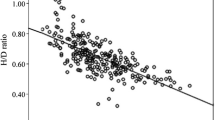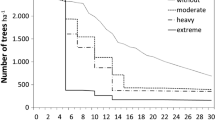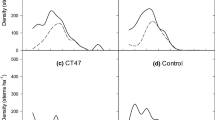Abstract
Thinning of Korean pine (Pinus koraiensis Sieb. et Zucc.) is used to facilitate timber and cone production. The present study in Northeast China investigated the effects of thinning intensity on individual tree growth, temporal variation in cone yield, and seed quality in Korean pine plantation. In 2005, five thinning intensity levels (none, extreme, heavy, moderate and light) were set in 15 permanent plots in a 32-year-old Korean pine plantation at Mengjiagang Forest Farm, Jiamusi City, Heilongjiang Province. We recorded tree growth and seed cone production from 2013 to 2016, i.e., from 8 to 11 years after thinning. Except for height growth, thinning increased tree growth (diameter at breast height and crown size) and improved cone yield. The extreme thinning treatment (to 300 trees per hectare) resulted in the largest tree diameter, tree volume, crown size and 4-year cone production per tree. The highest cone yield per tree in the mast year (2014) was observed when stands were thinned to 500 trees per hectare (heavy thinning). Although the best cone and seed quality and the largest cone and seed mass per tree were recorded in the heavily thinned stand, no significant differences were found between heavy and moderate thinning stands (750 trees per hectare). At the stand level, the moderately thinned stand had the highest basal area, stock volume and seed cone production per stand. Our results suggest that thinning to 750 trees per hectare will improve timber and cone productivity in 40-year-old P. koraiensis stands.



Similar content being viewed by others
References
Arista M, Talavera S (1996) Density effect on the fruit-set, seed crop viability and seedling vigour of Abies pinsapo. Ann Bot 77(2):187–192
Ayari A, Khouja ML (2014) Ecophysiological variables influencing Aleppo pine seed and cone production: a review. Tree Physiol 34(4):426–437
Ayari A, Zubizarreta-Gerendiain A, Tome M, Tome J, Garchi S, Henchi B (2012) Stand, tree and crown variables affecting cone crop and seed yield of Aleppo pine forests in different bioclimatic regions of Tunisia. Forest Syst 21(1):128–140
Bae SW, Hwang J, Lee ST, Kim HS, Jeong JM (2010) Changes in soil temperature, moisture content, light availability and diameter growth after thinning in Korean pine (Pinus koraiensis) plantation. J Korean For Soc 99(3):397–403
Bladon KD, Silins U, Landhausser SM, Messier C, Lieffers VJ (2007) Carbon isotope discrimination and water stress in trembling aspen following variable retention harvesting. Tree Physiol 27(7):1065–1071
Brix H (1993) Fertilization and thinning effect on a Douglas-fir ecosystem at Shawnigan Lake: a synthesis of project results. FRDA Report, 196. Forestry Canada and B.C. Ministry of Forests, Victoria, p 64
Calama R, Montero G (2007) Cone and seed production from stone pine (Pinus pinea L.) stands in Central Range (Spain). Eur J Forest Res 126(1):23–35
Choi J, Lee B, Lee D, Choi I (2014) Growth monitoring of Korean white pine (Pinus koraiensis) plantation by thinning intensity. J Korean For Soc 103(3):422–430
Climent J, Prada M, Calama R, Chambel RM, Ron DS, Alia R (2008) To grow or to seed: ecotypic variation in reproductive allocation and cone production by young female Aleppo pine (Pinus halepensis, Pinaceae). Am J Bot 95(7):833–842
Crone EE, Mcintire EJB, Brodie J (2011) What defines mast seeding? Spatio-temporal patterns of cone production by whitebark pine. J Ecol 99(2):438–444
Daniel TW, Helms JA, Baker FS (1979) Principles of silviculture. McGraw-Hill Book Corporation, New York, p 521
FAO (1998) Seeds, fruits, and cones. In: William MC (ed) Non-wood forest products from conifers. Food and Agriculture Organization of the United Nations, Rome, pp 72–87
Farris MA, Mitton JB (1984) Population density, outcrossing rate, and heterozygote superiority in Ponderosa pine. Evolution 38(5):1151–1154
González-Ochoa AI, López-Serrano FR, de las Heras J (2003) Does post-fire forest management increase tree growth and cone production in Pinus halepensis. For Ecol Manag 188(1–3):235–247
Goubitz S, Nathan R, Roitemberg R, Shmida A, Ne’eman G (2004) Canopy seed bank structure in relation to: fire, tree size and density. Plant Ecol 173(2):191–201
Harrington CA, Reukema DL (1983) Initial shock and long-term stand development following thinning in a Douglas-fir plantation. For Sci 29(1):33–46
Holland EP, James A (2015) Assessing the efficacy of population-level models of mast seeding. Theor Ecol 8(1):121–132
Horner GJ, Baker PJ, Nally RM, Cunningham SC, Thomson JR, Hamilton F (2010) Forest structure, habitat and carbon benefits from thinning floodplain forests: managing early stand density makes a difference. For Ecol Manag 259(3):286–293
Hou C, Wei ZG, Zhang LJ (2014) Effects of different thinning intensity on seed production stands of Pinus koraiensis in Mengjiagang Forest Farm. Chin For Sci Technol 20(1):41–46 (in Chinese)
Hummel S (2000) Height, diameter and crown dimensions of Cordia alliodora associated with tree density. For Ecol Manag 127(1–3):31–40
Jin XJ, Pukkala T, Li FR, Dong LH (2017) Optimal management of Korean pine plantations in multifunctional forestry. J For Res 28(5):1027–1037
Karlsson C (2000) Seed production of Pinus sylvestris after release cutting. Can J For Res 30(6):982–989
Kelly D (1994) The evolutionary ecology of mast seeding. Trends Ecol Evol 9(12):465–470
Knowe SA, Hibbs DE (1996) Stand structure and dynamics of young red alder as affected by planting density. For Ecol Manag 82(1–3):69–85
Kon H, Noda T (2007) Experimental investigation on weather cues for mast seeding of Fagus crenata. Ecol Res 22(5):802–806
Krannitz PG, Duralia TE (2004) Cone and seed production in Pinus ponderosa: a review. West N Am Nat 64(2):208–218
Latham P, Tappeiner J (2002) Response of old-growth conifers to reduction in stand density in western Oregon forests. Tree Physiol 22(2–3):137–146
Li YZ, Turnblom EC, Briggs DG (2007) Effects of density control and fertilization on growth and yield of young Douglas-fir plantations in the Pacific Northwest. Can J For Res 37(2):449–461
Madrigal J, Martínez E, Hernando C, Gujarro M, Díez C, Vega JA, Pérez-Gorostiaga P, Fonturbel T, Cuiñas P, Alonso M, Beloso MC (2004) Respuesta a corto plazo del regenerado post-incendio de Pinus pinaster Ait. a clareos mecanizadosintensos. Silva Lusit 12(1):1–14 (in Portuguese)
Mäkinen H, Isomäki A (2004) Thinning intensity and growth of Scots pine stands in Finland. For Ecol Manag 201(2–3):311–325
Mencuccini M, Piussi P, Sulli AZ (1995) Thirty years of seed production in a subalpine Norway spruce forest: patterns of temporal and spatial variation. For Ecol Manag 76(1–3):109–125
Moradi S, Limaei SM, Lohmander P, Khanmohammadi M (2017) Quantitative and financial evaluation of non-timber forest products (case study: Zemkan basin forests, West of Iran). J For Res 28(2):371–379
Moreno-Fernández D, Cañellas I, Calama R, Gordo J, Sánchez-González M (2013) Thinning increases cone production of stone pine (Pinus pinea L.) stands in the Northern Plateau (Spain). Ann For Sci 70(8):761–768
Moya D, Espelta JM, Verkaik I, López-Serrano F, Heras JDL (2007) Tree density and site quality influence on Pinus halepensis Mill. reproductive characteristics after large fires. Ann For Sci 64(6):649–656
Moya D, Heras JDL, López-Serrano F, Leone V (2008) Optimal intensity and age of management in young Aleppo pine stands for post-fire resilience. For Ecol Manag 255(8–9):3270–3280
Navarro FB, Jiménez MN, Cañadas EM, Gallego E, Terrón L, Ripoll MA (2010) Effects of different intensities of overstory thinning on tree growth and understory plant-species productivity in a semi-arid Pinus halepensis Mill. afforestation. For Syst 3(3):410–417
Ne’eman G, Izhaki I (2006) Stability of pre- and post-fire spatial structure of pine trees in Aleppo pine forest. Ecography 21(5):535–542
Ordonez JL, Retana J, Espelta JM (2005) Effects of tree size, crown damage, and tree location on post-fire survival and cone production of Pinus nigra trees. For Ecol Manag 206(1–3):109–117
Powers MD, Pregitzer KS, Palik BJ, Webster CR (2010) Wood δ13C, δ18O and radial growth responses of residual red pine to variable retention harvesting. Tree Physiol 30(3):326–334
Reukema DL (1961) Seed production of Douglas-fir increased by thinning. PNW Old Ser Res Note 210:1–5
Ruano I, Rodríguez-García E, Bravo F (2013) Effects of precommercial thinning on growth and reproduction in post-fire regeneration of Pinus halepensis Mill. Ann For Sci 70(4):357–366
Shen HL (2003) Korean pine as a nut production species in China present situation and future development. Acta Hortic 620:187–191
Sheng HC, Man XL, Cai TJ, Liu YC (2010) Seed setting pattern and sustainable management of Pinus koraiensis forests in Liangshui nature reserve. J Northeast For Univ 38(12):4–6 (in Chinese)
Shmida A, Lev-Yadun S, Goubitz S, Ne’eman G (2000) Sexual allocation and gender segregation in Pinus halepensis, P. brutia and P. pinea. Leiden. Backhuys Publisher, Leiden, pp 91–104
Stephenson AG (1981) Flower and fruit abortion: proximate causes and ultimate functions. Annu Rev Ecol Syst 12(1):253–279
Sucoff E, Hong SG (1974) Effects of thinning on needle water potential in red pine. For Sci 20(1):25–29
Sutton A, Staniforth RJ, Tardif J (2002) Reproductive ecology and allometry of red pine (Pinus resinosa) at the northwestern limit of its distribution range in Manitoba Canada. Can J Bot 80(5):482–493
Tapias R, Gil L, Fuentes-Utrilla P, Pardos JA (2001) Canopy seed banks in Mediterranean pines of south-eastern Spain: a comparison between Pinus halepensis Mill., P. pinaster Ait., P. nigra Arn. and P. pinea L. J Ecol 89(4):629–638
Teskey RO, Bongarten BC, Cregg BM, Dougherty PM, Hennessey TC (1987) Physiology and genetics of tree growth response to moisture and temperature stress: an examination of the characteristics of loblolly pine (Pinus taeda L.). Tree Physiol 3(1):41–61
Tong QJ, Zhang SY, Thompson M (2005) Evaluation of growth response, stand value and financial for precommercially thinned jack pine stands in Northwestern Ontario. For Ecol Manag 209(3):225–235
Trabaud L, Michels C, Grosman J (1985) Recovery of burnt Pinus halepensis Mill. forests. II. Pine reconstruction after wildfire. For Ecol Manag 13(3–4):167–179
Valinger E, Elfving B, Morling T (2000) Twelve-year growth response of Scots pine to thinning and nitrogen fertilisation. For Ecol Manag 134(1–3):45–53
Wang LP (2016) Effects of different thinning intensity on environment variables of Pinus koraiensis plantation forest. Liaoning For Sci Technol 3:19–22 (in Chinese)
Woodruff DR, Bond BJ, Ritchie GA, Scott W (2002) Effects of stand density on the growth of young Douglas-fir trees. Can J Forest Res 32(3):420–427
Wu J (2015) The study on fruiting regularities and cone production effect factor in Korean pine. Liaoning For Sci Technol 6:66–67 (in Chinese)
Yang HL, Wang X, Tao YZ, Gu Y (2007) Study on the tree volume table compilation of Korean pine in Liaoning province. Liaoning For Sci Technol 2:61–62 (in Chinese)
Zhang JW, Oliver WW, Ritchie MW (2007) Effect of stand densities on stand dynamics in white fir (Abies concolor) forests northeast California, USA. For Ecol Manag 244(1–3):50–59
Zhang Z, Zhang HG, Yang CP, Zhang L, Du J, Jiang Y (2016) Clonal variations in nutritional components of Pinus koreansis seeds collected from seed orchards in Northeastern China. J For Res 27(2):295–311
Acknowledgements
We appreciate Dr. David South, Emeritus Professor of the School of Forestry and Wildlife Sciences, Auburn University, USA, for language revision. We thank the anonymous reviewers for their constructive suggestions. We also thank the Mengjiagang Forest Farm for providing the research site and helping our investigation.
Author information
Authors and Affiliations
Corresponding author
Additional information
Project Funding: This study is supported by National Key R&D Program of China (2017YFD0600601).
The online version is available at http://www.springerlink.com
Corresponding editor: Zhu Hong.
Rights and permissions
About this article
Cite this article
Nguyen, T.T., Tai, D.T., Zhang, P. et al. Effect of thinning intensity on tree growth and temporal variation of seed and cone production in a Pinus koraiensis plantation. J. For. Res. 30, 835–845 (2019). https://doi.org/10.1007/s11676-018-0690-x
Received:
Accepted:
Published:
Issue Date:
DOI: https://doi.org/10.1007/s11676-018-0690-x




